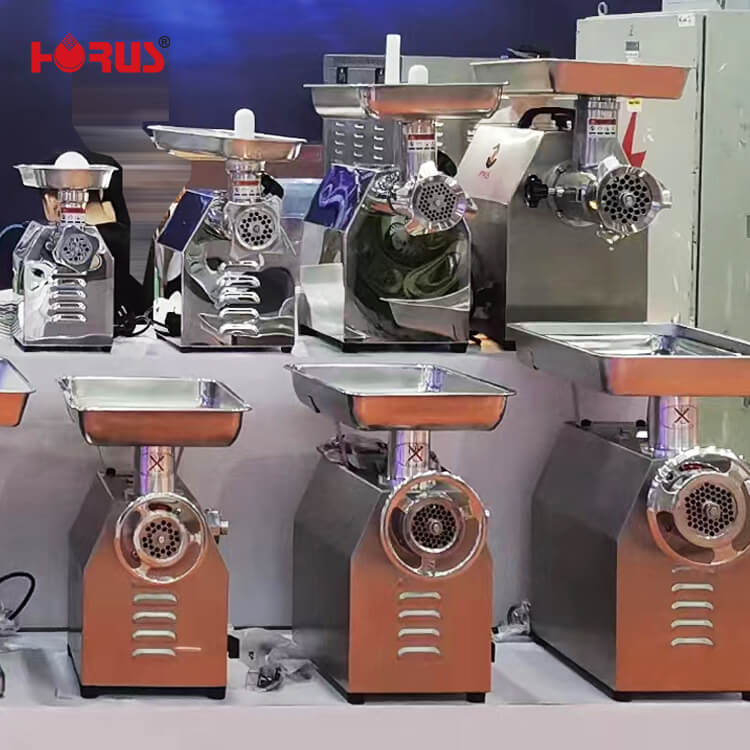For restaurants, meat processors, supermarkets, and food distributors, a commercial meat grinder is more than equipment—it’s a profit engine. B2B buyers demand machines that handle high volumes, minimize downtime, and adapt to unique production workflows. But in a market saturated with generic options, how do you choose a grinder that aligns with your business’s exact needs? This guide explores the critical role of customization in commercial meat grinders and how it translates to ROI for B2B buyers.
1. Why B2B Food Businesses Need Customized Meat Grinders
A. The Limitations of Off-the-Shelf Models
One-Size-Fits-None: Pre-configured grinders often lack the power (HP), throat size, or safety features required for specialized tasks (e.g., grinding frozen meat blocks).
Compliance Risks: Generic models may fail to meet industry-specific certifications (e.g., NSF, FDA, CE), risking fines or shutdowns.
B. The Customization Advantage
Tailored Capacity: Match grinder size to daily output (e.g., 500 lbs/hour for delis vs. 5,000 lbs/hour for slaughterhouses).
Material Flexibility: Choose between stainless steel (corrosion-resistant) or carbon steel (cost-effective) based on product types.
Safety Add-Ons: Include emergency stops, blade guards, and slip-resistant feet to meet OSHA standards.
2. Key Customization Options for B2B Meat Grinders
A. Power & Motor Configuration
Variable Horsepower: Select motors from 3HP (small butchers) to 20HP+ (industrial plants) based on throughput needs.
Voltage Compatibility: Customize for 220V, 380V, or 480V to align with local power grids.
B. Grinder Plate & Blade Design
Plate Hole Sizes: Choose from 3/16” (fine grind for sausages) to 1/2” (coarse grind for chili).
Blade Materials: Opt for titanium-coated blades for extended lifespan in high-abrasion environments.
C. Production-Specific Add-Ons
Frozen Meat Attachments: Auger upgrades for grinding -20°F meat without pre-thawing.
Vacuum Stuffing Systems: Integrate with grinders for seamless sausage production.
Mobile Carts: Add locking casters for easy movement in multi-station kitchens.
3. How to Evaluate Custom Meat Grinder Suppliers
A. Manufacturing Capabilities
In-House Engineering: Ensure the supplier can modify gear ratios, housing dimensions, and control panels.
Certifications: Verify compliance with ISO 9001, NSF, and local safety regulations.
B. B2B-Focused Support

4. Maintenance Strategies for Custom Grinders
A. Preventative Care Checklist
Daily: Clean blades with food-safe degreasers; check oil levels in air-cooled motors.
Weekly: Inspect electrical wiring for fraying; lubricate gears with food-grade grease.
Annually: Replace worn plates/blades; recalibrate motor belts.
B. Warranty Considerations
Look for 2–5 year warranties on motors and 1 year on blades.
Avoid suppliers with “void if modified” clauses, which penalize customization.
5. Case Study: How Customization Saved a Food Processor $120K/Year
Client: Mid-sized ground beef supplier (50 employees).
Problem: Off-the-shelf grinders jammed frequently, causing 4 hours/week in downtime.
Solution: Customized grinder with:
Larger throat size (12” vs. standard 8”) to accommodate whole pork shoulders.
Reinforced auger for frozen meat grinding.
Automated lubrication system.
Result:
60% reduction in downtime.
22% faster throughput.
ROI achieved in 14 months.
6. FAQs for B2B Meat Grinder Buyers
Q: Can custom grinders handle bone-in meat?
A: Yes, but require bone-grinding attachments and motors rated for continuous heavy-duty use.
Q: How long does customization take?
A: Lead times range from 4–12 weeks, depending on complexity (simple plate changes vs. full motor redesigns).
Q: What’s the minimum order quantity (MOQ) for custom models?
A: Most suppliers require MOQs of 5–10 units for full customization, but offer partial mods (e.g., plate changes) for single units.
Conclusion: Customization as a Competitive Edge
In a market where downtime costs 250–500/hour (FSR Magazine), generic meat grinders are a liability. By partnering with suppliers who offer modular designs, B2B buyers can optimize for speed, safety, and compliance—all while reducing long-term costs.
Ready to Design Your Custom Grinder?
Explore our B2B meat grinder customization portal, where you can select power, attachments, and materials. For bulk orders, contact our B2B team for a free ROI analysis.









